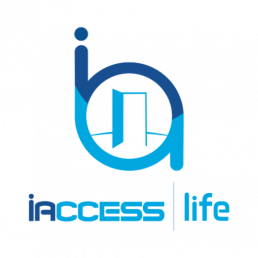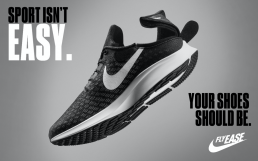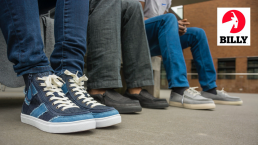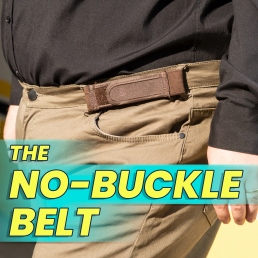What is adaptive clothing?
Adaptive clothing is apparel that is specifically designed to make dressing easier for individuals with special needs including physical disabilities, spinal cord injuries, and learning disabilities. Many of these folks are unable to manipulate things like zippers, buttons, and other similar closures or have limited mobility which makes self-dressing difficult. Most clothing items have closures like zippers and buttons that are difficult for people with special needs and their caregivers to work around. Adaptive clothing reimagines closures in apparel with useful replacements like Velcro or magnets. A general misconception is that adaptive clothing is only meant for individuals who use wheelchairs or those with severe injuries, but that’s just not the case! Anyone limited by general clothing designs can benefit from adaptive clothing. Professional health care providers and caregivers also benefit from adaptive clothing as it protects them from shoulder and back injuries and makes them more efficient in their work.
Types of adaptive clothing & special needs clothing
Adaptive clothing is specially adapted to make dressing easier, improve comfort and promote independence for individuals with disabilities or limited mobility. Many designs for adaptive clothing have flat seams that reduce friction and are even adapted to be consistent with the latest fashion norms as much as possible.
- Those suffering from Paraplegia, Quadriplegia, MD, SCI, MDS MS and contractures often have limited control of certain parts of their body and find it extremely difficult to move joints or even bend muscles. Their clothes, therefore, are specially adapted with an open rear, which enables their wear to be easily put on from the front, making it unnecessary to bend or rotate muscles and joints.
- For individuals who have Alzheimer’s disease, locked clothing is the preferred choice to make it difficult for them to disrobe during inappropriate moments.
- Those with Edema disease have their pants made with a unique design so that the pants can be easily adjusted in size and similarly adaptive shoes. They also have closures that are non-restrictive. Traditional footwear and pants are difficult to wear because of the swelling of legs and feet.
- For those with incontinence disease, their adaptive wear comes specially adapted so that they can be removed quickly, easily and discreetly. This clothing comfortably accommodates their limited bladder control and urgency.
- People living with Arthritis and Parkinson’s disease have limited motor skills, so their clothing has incorporated comfortable touch magnetic and Velcro closures, which are better and more efficient than zippers and buttons.
The Best Adaptive Clothing Brands
These brands make quality adaptive garments and accessories that make getting dressed much easier for the physically disabled and their caregivers
The team at BraEasy has invented a Bra that you can put on with 1 hand, and take off with just 2 fingers. Rachel, the CEO and founder of BraEasy has a daughter who had a stroke during surgery to remove a brain tumor when she was just nine years old. When her daughter was 15, Rachel realized that because of the stroke she wasn’t able to put on and take off a bra. After searching for years and finding nothing, she invented a bra that worked. It had to be beautiful and it had to be functional. Other options don’t cater for you to be able to put it on with one hand easily. This product is changing women’s lives across the world. This is what BraEasy is all about. Making the world a better inclusive place for all woman. This Bra is designed for women who are elderly, disabled, injured or limb different. Also ideal for wheelchair users, as this Bra fastens at the side!
See below for a video of how this unique Bra works.
The goal of BraEasy is to enable ALL women to be able to dress quickly, more easily, and independently with dignity.
We are keen to raise awareness that there is now a dressing solution available.
In July 2014, a Zappos employee took a call from a customer who had received the wrong size shoes. The shoes the customer ordered were adult-sized sneakers that had a hook and loop closure instead of traditional shoelaces. The employee apologized for sending the wrong size and tried to replace them for her but the size she wanted simply wasn’t available and he couldn’t find a similar replacement.
After hearing the news, the customer was frustrated and shared that the shoes were for her autistic grandson who was unable to tie his own shoelaces. Now that he was getting older and his feet were getting bigger, it was more difficult to find trendy athletic lace-less shoes.
The employee took down some notes and told the customer he would see what he could do. That call made a lasting impression on the employee and he vowed to do something about it. After several months of immersive research, education, and talking with families and people with disabilities, he identified that there was a huge gap when it came to clothing and footwear that could help make getting dressed easier and he felt Zappos could bridge that gap. A team dedicated to sourcing products that are functional, fashionable, and meet all types of needs was formed and Zappos Adaptive was born.
The Zappos Adaptive website launched in April 2017 with two new brands. Since then, they have continued to curate adaptive clothing and shoes and have since added Nike FlyEase, Tommy Hilfiger Adaptive, BILLY Footwear and several more brands that have innovative products that meet the needs of our customers with disabilities.
Zappos listens to customers feedback, reads customer reviews, speaks with people with disabilities at events like the Abilities Expo, researches continuously, works with experts like their Advisory Council, and conducts focus groups to learn what people need.
Today Zappos Adaptive offers a broad assortment of easy-on/off shoes, sensory-friendly clothing, reversible shirts and pants, clothing with magnetic fasteners, post-surgical clothing, diabetic shoes, and more. Although there is a long way to go to work adaptive clothing into mainstream design, Zappos Adaptive aims to connect people with products that make life easier and has done an impeccable job dedicating resources to creating an easy shopping experience for those seeking functional yet fashionable adaptive clothing.
In July 2015, 16-year-old Matthew Walzer, who has cerebral palsy, wrote a letter to the company asking Nike to consider developing a shoe design for people who may have trouble tying shoelaces. Nike introduced FLYEASE on its Zoom Soldier 8 model, inspired by Matthews Letter.
Nike shoe designer, Tobie Hatfield, read Matthew’s request and started developing a prototype for a shoe Matthew and other people with disabilities could wear comfortably. Now, the FLYEASE technology is available on the Lebron Soldier 9, Pegasus 32 and Flex Run shoe models, too. Nike now has a wide variety of running and basketball shoes with its FlyEase entry system, designed for both kids and adults of all abilities. FlyEase technology includes a strap and zipper that goes around the heel of the shoe making it easier to pull the shoe on and off.
These Nike easy-entry footwear systems are designed to help athletes of ALL abilities put on and secure their shoes—with zero compromise to fit and performance. FlyEase is a new standard in universal design. Nike has re-imagined footwear to expand access and unlock benefits for all athletes.
Tommy Hilfiger is one of the most recognizable apparel brands in the world. The brand gets its namesake from world renowned American fashion designer Tommy Hilfiger. In 2012, after months of starring in public service announcement for the nation’s largest autism advocacy group, Tommy Hilfiger opened up about his personal connection to the disorder. Hilfiger revealed that his then 16-year-old daughter and his stepson both were living with autism.
In Spring 2016, Tommy Hilfiger launched an adaptive clothing line for kids with autism and other special needs. That clothing line proved to be so popular that in Fall 2017, Tommy Hilfiger expanded his adaptive clothing line to include adult sizes. The adaptive clothing line mirrors the style of the iconic Tommy Hilfiger brand but with slight adjustments like zippers and buttons replaced by Velcro and magnetic buttons. Tommy Adaptive puts a new twist on tradition, delivering modern style with innovative modifications that empower people and make dressing easier.
“For one in five Americans living with a disability, something as simple as getting dressed each day can be a challenge. Inspired by their experiences and Tommy’s own history having children with autism, our team made a commitment to rethink the design process to uncover solutions that really work.”
BILLY Footwear, was founded by Darin Donaldson and Billy Price. Billy footwear focuses on shoes that embody universal design, meaning they both appeal to and work for everyone. The term, “universal design” is thrown around with respect to construction of homes, businesses and municipal buildings, referring to environments that accommodate all parties. In fact, buildings with universal design are the very buildings we aim to highlight with our iAccess Life mobile app for rating & reviewing accessibility of public places. Universal design has also permeated to technology with the advancements and popularity of smart phones, which incorporate features to improve the user experience for individuals with vision, hearing, and mobility impairments so they may access all the same information. Billy Footwear thought that if the designs of structures and technology can universal, then why not fashion?
“Smashing fashion with function, BILLY Footwear incorporates zippers that go along the side of the shoes and around the toe, allowing the upper of each shoe to open and fold over completely. Thus the wearer can place his or her foot onto the shoe footbed unobstructed. Then with a tug on the zipper-pull the shoe closes and secures overtop the user’s foot. It’s simple. It’s easy.”
On October of 1996, BILLY Footwear founder Billy Price became paralyzed from the chest down after breaking his neck from a three-story fall. Billy lost the ability to move much of his body, including his fingers. Daily tasks that he took for granted, such as putting on clothes, became much more difficult. Over time Billy learned tricks for getting dressed more easily but the one piece of clothing that always eluded him was shoes, he never found a pair of shoes that he felt were both attractive and that he could put on independently.
Half a lifetime later, a solution was born. “Between Billy’s propensity for problem-solving and Darin’s spark for business innovation, they created a prototype that fulfilled Billy’s personal needs. But the solution Billy was seeking for his own challenges grew into something bigger—it became a mission to create mainstream shoes that are functional, fashionable, and inclusive for everyone.”
We are HUGE fans of BILLY Footwear and love their fashionable yet functional designs.
BeltBro was designed to help those with Crohn’s, IBS, and any other disability or ailment that makes wearing traditional belts difficult. As they have expanded, they also desired to make a no-buckle belt for kids with autism and focused on medical devices for post surgery, wheelchair, and other health related needs.
Soon after launching, it became clear there were many other types of customers ordering their comfortable, ultra-light weight no buckle belts! Many recently lost weight or simply wanted to try a more comfortable belt alternative. Within 3 years, BeltBro has become the the top-selling belt around the world used by fisherman, guitarists, car mechanics, truckers and so many others! As a company with less than 10 employees, they believe in keeping things small and simple. BeltBro is here to help you feel more comfortable.
Adaptive clothing makes getting dressed easier for the disabled
These brands will cater for individuals of all ages with varying degrees of disabilities and they will provide you with the latest and most innovative products available to ensure you carry on with your daily activities as smoothly and comfortably as possible. If you would like to learn more about adaptive clothing, please check out this fantastic Ted Talk on how Adaptive Clothing empowers people with disabilities. We also recommend you download the iAccess Life app for rating & reviewing the accessibility of public places. App users will notice that we frequently highlight specific adaptive products including adaptive clothing throughout the app.
